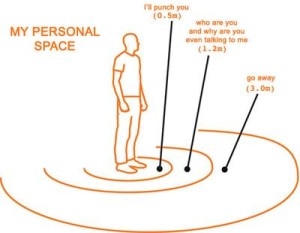
Whether you have chosen to take self-defense or martial arts training to increase your personal safety or have purchased some device or weapon to enhance your personal safety, there is one dynamic most overlook regarding any and all of these — proximity.
The element-of-surprise plays in heavily to an attackers M.O. for obvious reasons. If they can move before you move, they are acting and you are only “reacting” which means time in the moment is on their side. In a hand-to-hand scenario this is why many muggings, rapes, and similar are successful. First, the would-be victim often has no such (hand-to-hand) training, and second they are left to react in the moment with lack of said training. This is seldom, if ever, going to play out well for the intended victim(s).
Police academies and departments often employ the “21-foot rule”, meaning if you let a potential assailant within 21′ of you, the odds are in their favor that they will get to “you” before you will be able to get to your gun. If they have a knife or similar, this can become a life-threatening scenario for sure. Yet I hear every-day people bragging with an unjustified bravado how, if attacked, they will take care of the assailant with their gun, whether hidden from view or openly carried. Think about that for a moment as even the POLICE do not see this happening, so is that reality or fantasy when applied to civilians as a valid defense and strategy? The same is true for pepper spray, stun guns, and the like.
If you do not “SEE” the attack coming, it will come, and you will be left to playing catch-up in a moment of intense pressure and potential harm. This is why personal space should be every bit as much a part of your personal safety strategy as physical defense or use of a weapon. In fact, it should be the #1 part of any such strategy! If you let a would-be attacker too close within your personal space, the odds (just as the police have tragically learned) are on the attacker’s side.
It is often a “good story” that is employed to breach such spaces. It is the person “you think” is approaching to ask/offer help; it is the person “you think” can do you no harm (older, younger, female, etc.); it is the person “you think” has an emergency needing your assistance; it is the person “you think” is friend not foe. Does this mean we live in a world of fear or paranoia? No, of course not. It just means we approach such encounters mindful of (a) PERSONAL SPACE and (b) discernment.
Make it clear when unknown people (regardless of age, gender, perceived injury, etc.) approach you that you are aware of them entering YOUR personal space. Reflect their movement coming towards “you” with your movement away from “them”. They take two steps forward, you take two steps backward, preferably with hand or hands up in a warning/defensive posture. And also, be aware of “your six” as they would say in military terms, just in case the person “in front of you” is the distraction while someone is coming up from “behind you”.
Personal space is never something you should take for granted. Regardless of your training, regardless of your weapon(s) of choice, if someone gains that upper hand via proximity, the odds are not in your favor — period. Know that space, know yourself, know your potential enemy and their purpose in movement. And if you “spot” them as they purposefully move closer and closer towards you, this is now spotting trouble “BEFORE” trouble spots you! Be aware of such tactical movement.
How close is “too close”? Listen to your instincts, not your ego.
Jeff McKissack, Founder
Trouble Spotters